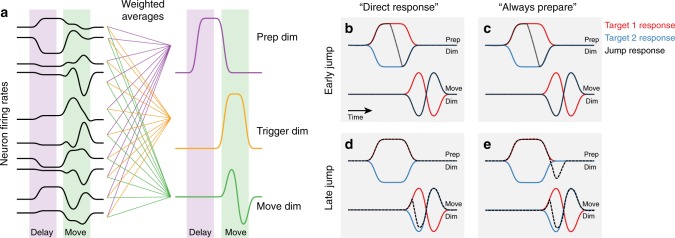Fig. 1.
Cartoon of neural hypotheses. a To identify important signals in the neural population, we can project them into new dimensions. Activity in each dimension is calculated as a weighted average of the firing rates of all neurons. In motor cortex, there tend to be separate dimensions active during movement preparation and movement generation (which tend to have different firing rates across different reaching directions), as well as a trigger dimension which changes in a consistent manner prior to movement for all reach directions. b Direct Response Hypothesis, early jumps: For jumps which occur while the motor cortex is still in the preparatory period (before or just after the go cue), neural activity after a jump (dotted black) should transition from preparing a reach to the first target (red) to preparing a reach to the final target (blue). Because the neural correction to the target jump is completed before movement onset, target-jump activity in movement dimensions should be similar to a reach to the final target. c Always Prepare Hypothesis, early jumps: For jumps which occur while the motor cortex is still in the preparatory period (before or just after the go cue), the neural correction is in the preparatory dimensions, so the neural predictions of the direct response hypothesis and the always prepare hypothesis are the same. d Direct Response Hypothesis, late jumps: For target jumps which occur close to the onset of movement, there is no difference in the preparatory space between the pattern of activity for the first (red) and second jumps (blue). Under the Direct Response Hypothesis, we would therefore expect to see the response to the target jump occur exclusively in the movement-related neural dimensions. e Always Prepare Hypothesis, late jumps: Under the Always Prepare Hypothesis, motor preparation must be re-engaged following a target jump. We would thus expect to see a target jump response in the preparatory dimensions, even though these dimensions are not ordinarily active during movement

